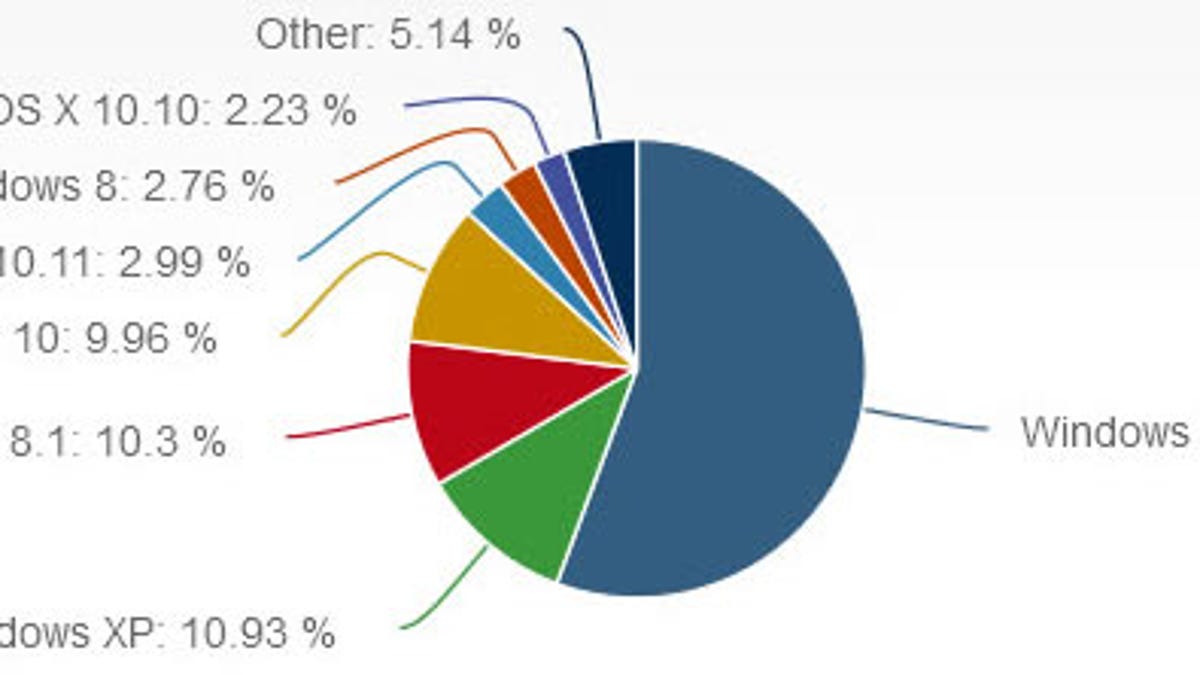Windows 10 budges a bit as masses cling to Windows 7
Microsoft crows that its new software now has 200 million monthly users. Still, that hasn't moved the needle much when it comes to displacing older versions.
Microsoft's Windows 10 is free for Windows 7 and 8.1 users, but people aren't exactly rushing to upgrade.
The latest version of the Windows software, released in late July, snagged a 9.96 percent share of all Web traffic generated by desktop operating systems in December, tracking company NetMarketShare said Friday. That's up from 9 percent in November, continuing a tepid pace for Windows 10 following an initial burst of energy in the first month after the software hit the market.
The report is in sharp contrast to Microsoft's upbeat announcement Monday that Windows 10 has seen an "incredible response" with more than 200 million devices worldwide running the software. That number includes tablets and smartphones, not just desktop PCs. The company also said that Windows 10 adoption is accelerating, with more than 40 percent of new Windows 10 devices having been activated since Black Friday in late November.
"Windows 10 continues to be on the fastest growth trajectory of any version of Windows -- ever -- outpacing Windows 7 by nearly 140 percent and Windows 8 by nearly 400 percent," Yusuf Mehdi, the head of Microsoft's Windows and Devices Group.
Still, there's a long way to go for the newest version of the world's most widely used PC operating system.
NetMarketShare noted that Windows 10 is within striking distance of Windows XP and Windows 8.1, which saw their Web traffic shares drop last month to 10.9 percent and 10.3 percent, respectively. But those declines can be explained in part by the fact that XP is no longer supported by Microsoft and that some 8.1 users are likely taking advantage of Microsoft's offer of a free upgrade to Windows 10.
A Microsoft spokeswoman said the company does not comment on third-party data.
The poky uptake of Windows 10 over the past five months comes as Microsoft tries to prove it can still make a compelling, user-friendly operating system after the washout of Windows 8, which alienated many with a radically new look and feel. Windows 10 is also designed to work across a variety of devices from PCs to tablets to mobile phones, so Microsoft is hoping its newest version of Windows can grab more users across its entire ecosystem.
Windows 7 scored a Web traffic share of 55 percent last month, according to NetMarketShare. That figure has changed little since December 2014 and is still enough to keep the software far ahead of the rest of the pack.
The software giant has aggressively been trying to coax people to shift to Windows 10, pushing the upgrade through frequent pop-up reminders for Windows 7 and 8.1 users. The company classified Windows 10 as an "optional update" last year. Microsoft expects to change that to "recommended update" early this year.
Microsoft is so keen to shift people to Windows 10 that one executive has begun striking a note of caution about Windows 7. "Windows 10 is a much better place than Windows 7," Microsoft marketing chief Chris Capossela said last week on the Windows Weekly podcast.
"We do worry when people are running an operating system that's 10 years old that the next printer they buy isn't going to work well, or they buy a new game, they buy Fallout 4, a very popular game, and it doesn't work on a bunch of older machines," Capossela said, apparently referring to Windows 7, according to a transcript of the interview from BetaNews.
The comment is odd because Windows 7 is six years old and still seems healthy. Microsoft discontinued free support for Windows 7 a year ago, but paid support will continue to 2020. Bug fixes, patches and other updates will also keep rolling out until the end of this decade, ensuring that Windows 7 will remain protected against malware and other threats.
Update, 8:35 a.m. PT: Added information from Microsoft's Monday announcement, along with a statement from a Microsoft spokeswoman.


